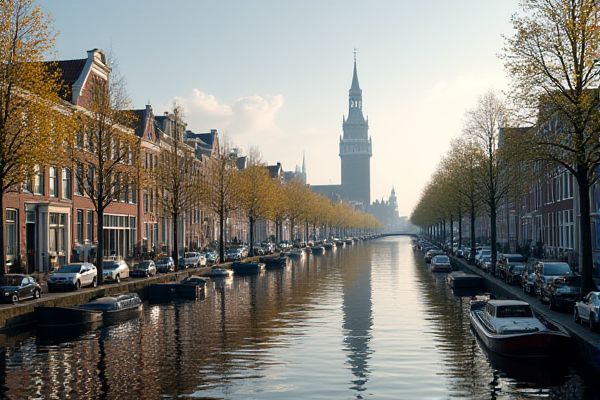
Dining and food culture in Netherlands: Dutch cuisine emphasizes simplicity and freshness. Breakfast includes bread, cheese, and cold cuts. Dinner typically served early, around 6 PM. Lunch is often a quick sandwich or soup. Bitterballen: popular snack in pubs. Stroopwafels: traditional Dutch sweet treat. Haring: raw herring, a local delicacy. Many vegetarian and vegan-friendly options available. Influences from Indonesian and Surinamese cuisines. Tap water is safe and widely used.
Dutch cuisine emphasizes simplicity and freshness.
Traditional Dutch cuisine places a strong emphasis on simplicity and freshness, showcasing the rich flavors of fresh, seasonal ingredients. These dishes are often crafted from age-old recipes that have been lovingly passed down through generations, beautifully reflecting the Netherlands' agricultural heritage and coastal influences. For more insights into these timeless culinary treasures, explore the journey at Amsterdam Life Homes and discover the delightful simplicity that defines Dutch food.
Breakfast includes bread, cheese, and cold cuts.
A typical Dutch breakfast and lunch often include bread, cheese, and cold cuts, along with other toppings like chocolate sprinkles, peanut butter, and jam, accompanied by drinks such as milk, coffee, and juice. For more details on these delightful meals, visit the Amsterdam Canal Cruises website, which provides a comprehensive guide on typical Dutch meals and more. The diversity of flavors and simplicity in preparation make Dutch cuisine an interesting exploration for culinary enthusiasts around the world.
Dinner typically served early, around 6 PM.
In the Netherlands, dinner is typically served early, between 5 PM and 6 PM, a tradition influenced by historical socio-economic factors and the necessity for a warm meal after a day of work. Common dishes include stamppot, soups, and meat with potatoes and vegetables. For more insights into traditional Dutch dining, visit the Dutch Review website, which provides a deeper look into the customs, typical dishes, and notable dining venues in the region.
Lunch is often a quick sandwich or soup.
Lunch in the Netherlands is typically a quick and light meal, often consisting of sandwiches (known as "broodjes" or "boterhams") or soup, emphasizing simplicity and maintaining productivity for the rest of the workday. For more in-depth insights into Dutch Lunch Culture, please visit the Dutch Review website to explore how bread and societal norms shape this unique tradition.
Bitterballen: popular snack in pubs.
Bitterballen are a popular Dutch bar snack, consisting of fried balls filled with a creamy roux made from broth, butter, flour, and meat, usually beef or veal. They are often served with yellow mustard and are typically enjoyed in pubs and cafes alongside beer. This savory delight is celebrated on the culinary platform Dumpling Hunter, where food enthusiasts can explore its rich heritage and recipe details. The combination of flavors and textures makes Bitterballen a quintessential treat in Dutch gastronomy.
Stroopwafels: traditional Dutch sweet treat.
Stroopwafels are traditional Dutch sweet treats consisting of two thin, crispy waffle-like cookies sandwiched together with a caramel syrup filling. They originated from Gouda in the 19th century and are often enjoyed with hot beverages like coffee or tea for their unique texture and balanced sweet and savory flavors. For more information about these delightful treats, you can visit the Dutch Waffle Company website.
Haring: raw herring, a local delicacy.
In the Netherlands, "Haring" or herring, though not raw, is a beloved delicacy. It is prepared by freezing and then salting the herring, often served with raw onion and pickles, traditionally eaten by holding the tail and consuming it in a few bites. This culinary tradition is particularly celebrated during events like Ash Wednesday and Vlaggetjesdag (Flags Day). For more information about this cultural delight, visit the Aronson website.
Many vegetarian and vegan-friendly options available.
The Netherlands offers a diverse and vibrant dining scene with numerous vegetarian and vegan-friendly options across major cities like Amsterdam, Utrecht, The Hague, Rotterdam, and Groningen. Restaurants such as Vegan Junk Food Bar, TerraZen Centre, Gys, BROEI, and Veggies on Fire provide a wide range of plant-based dishes, from comfort food to fine dining, highlighting the country's growing commitment to sustainable and plant-based cuisine.
Influences from Indonesian and Surinamese cuisines.
The Dutch food culture has been significantly influenced by Indonesian and Surinamese cuisines, reflecting the country's colonial history. Dishes like rijsttafel, nasi goreng, and rendang from Indonesian cuisine, and roti and pom from Surinamese cuisine, showcase the fusion of spices and cooking techniques from these regions, highlighting the cross-cultural exchange and culinary legacy of the Dutch East Indies and Dutch colonial era.
Tap water is safe and widely used.
In the Netherlands, tap water is exceptionally safe and widely used due to stringent government regulations, rigorous testing, and advanced treatment processes, making it one of the purest and healthiest tap water sources globally. For those interested in learning more about the safety and quality of drinking water in this country, you can check out this comprehensive Guide to Drinking Water in The Netherlands. The quality assurance measures in place ensure that residents and visitors can confidently consume tap water without worry.
